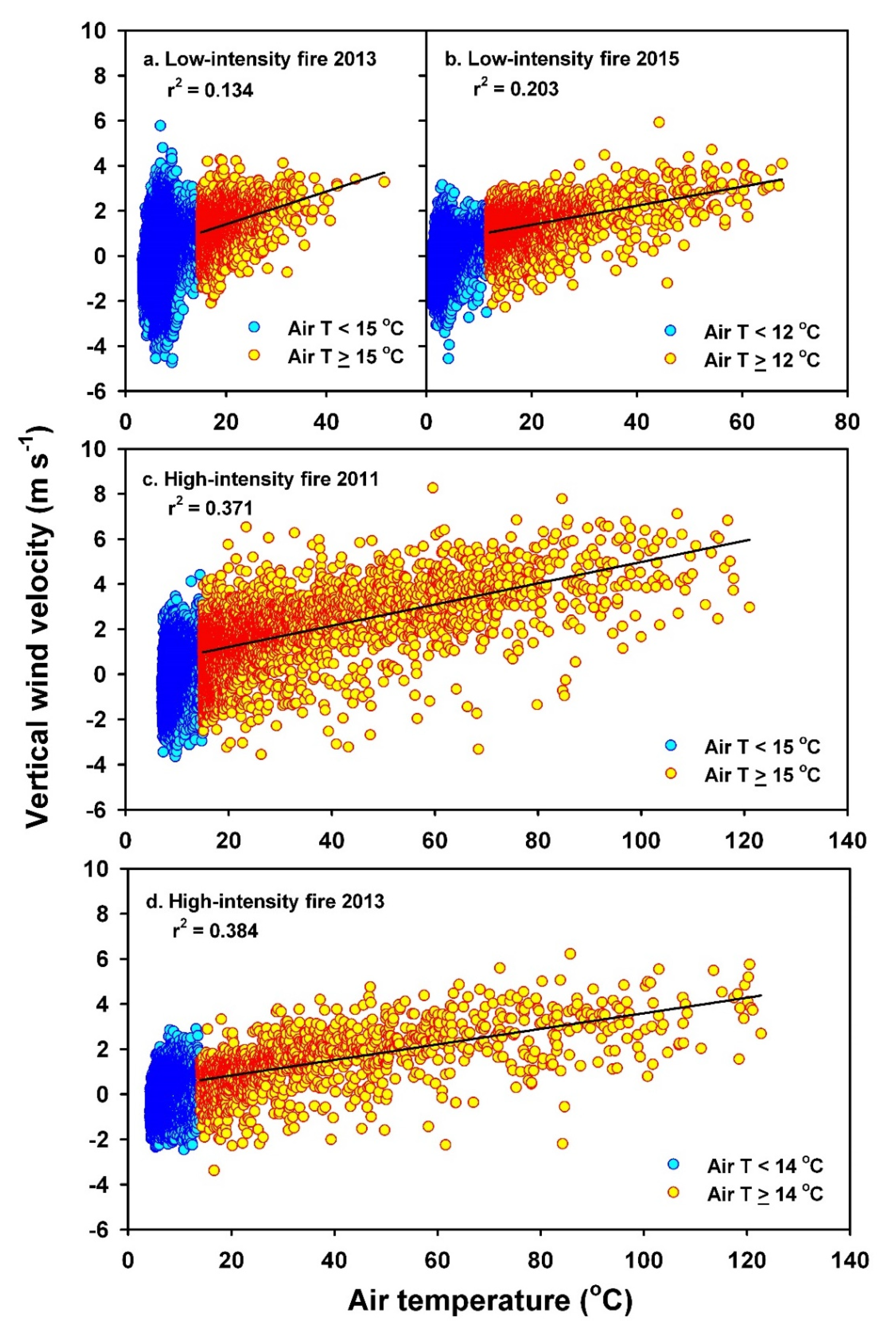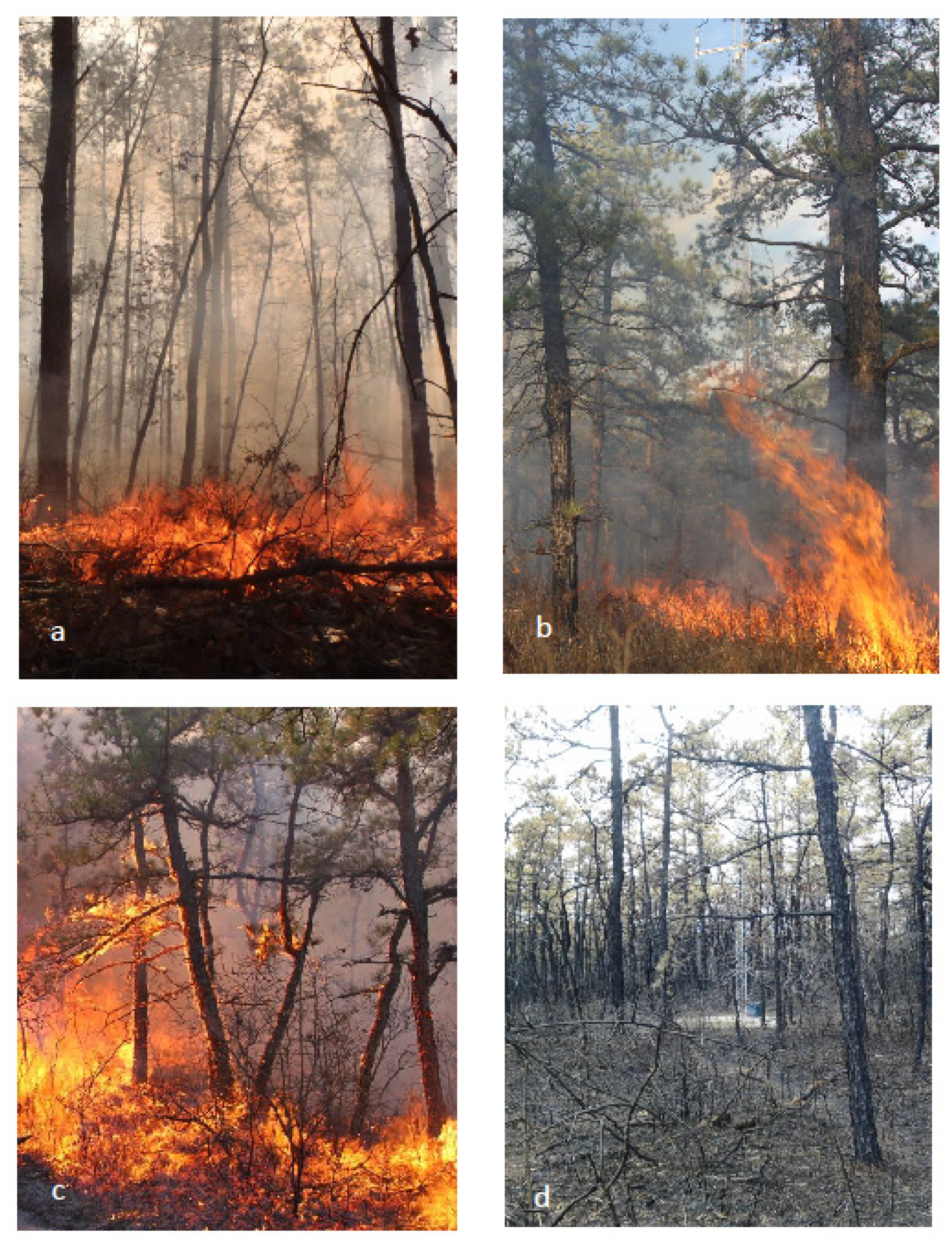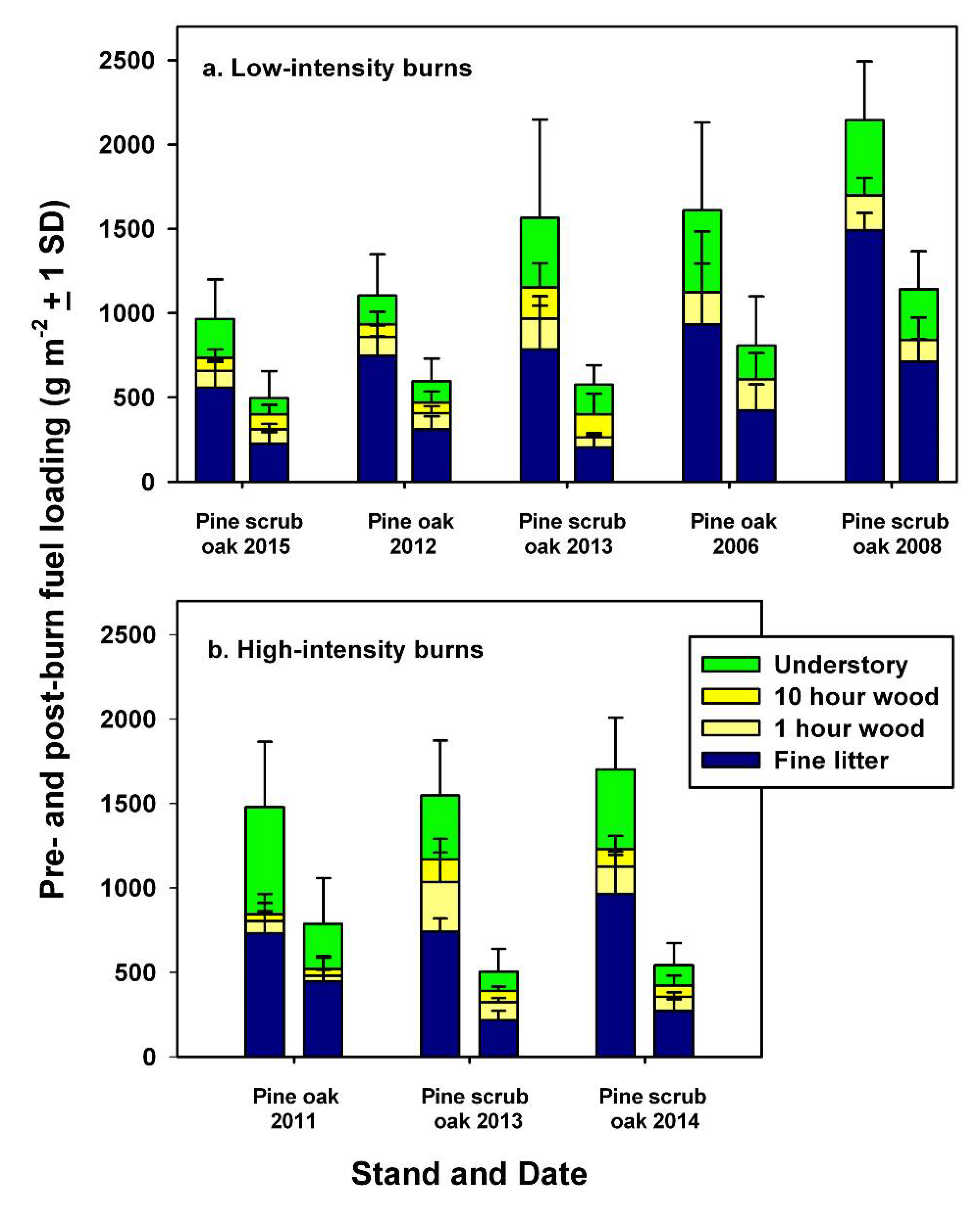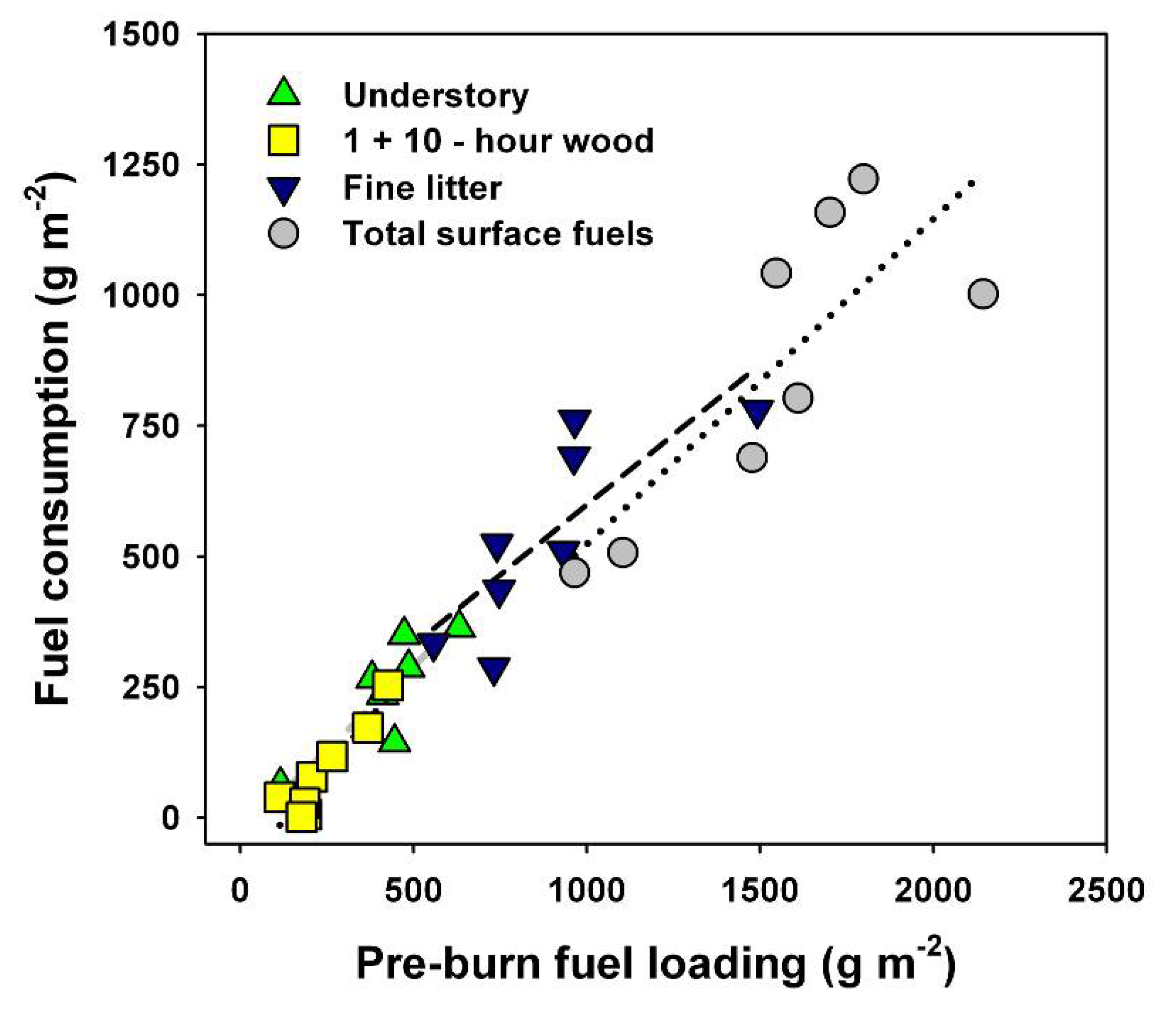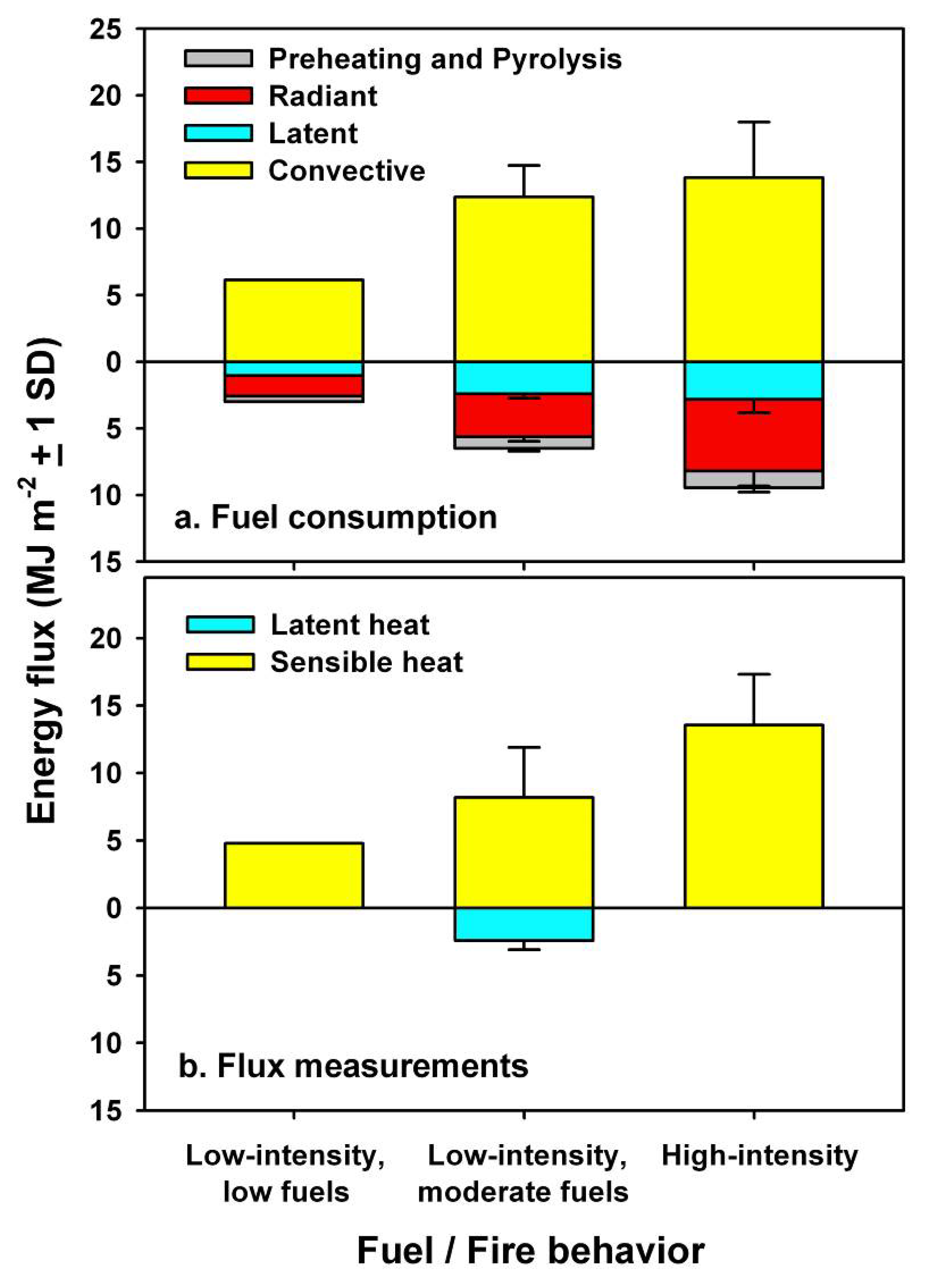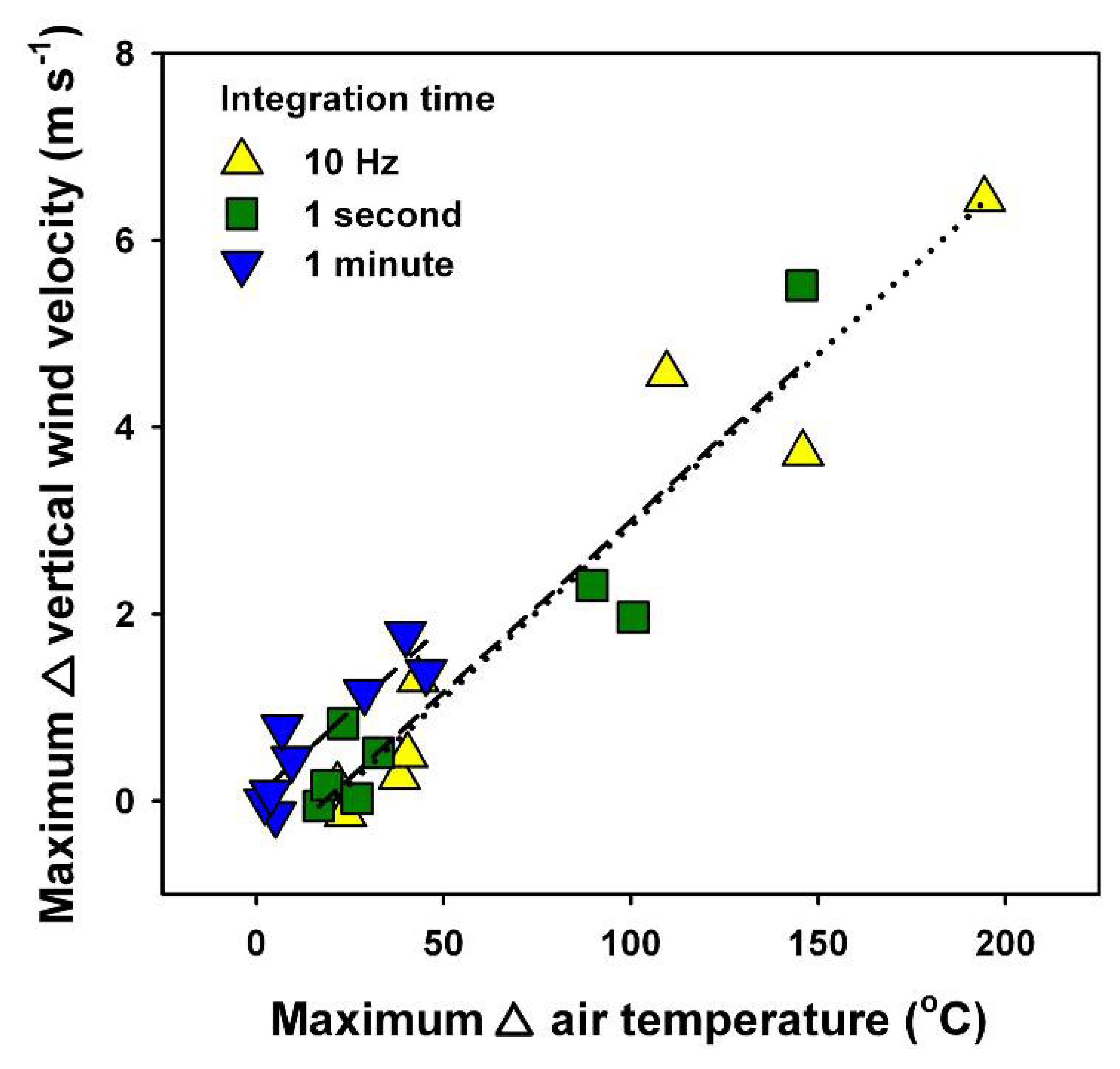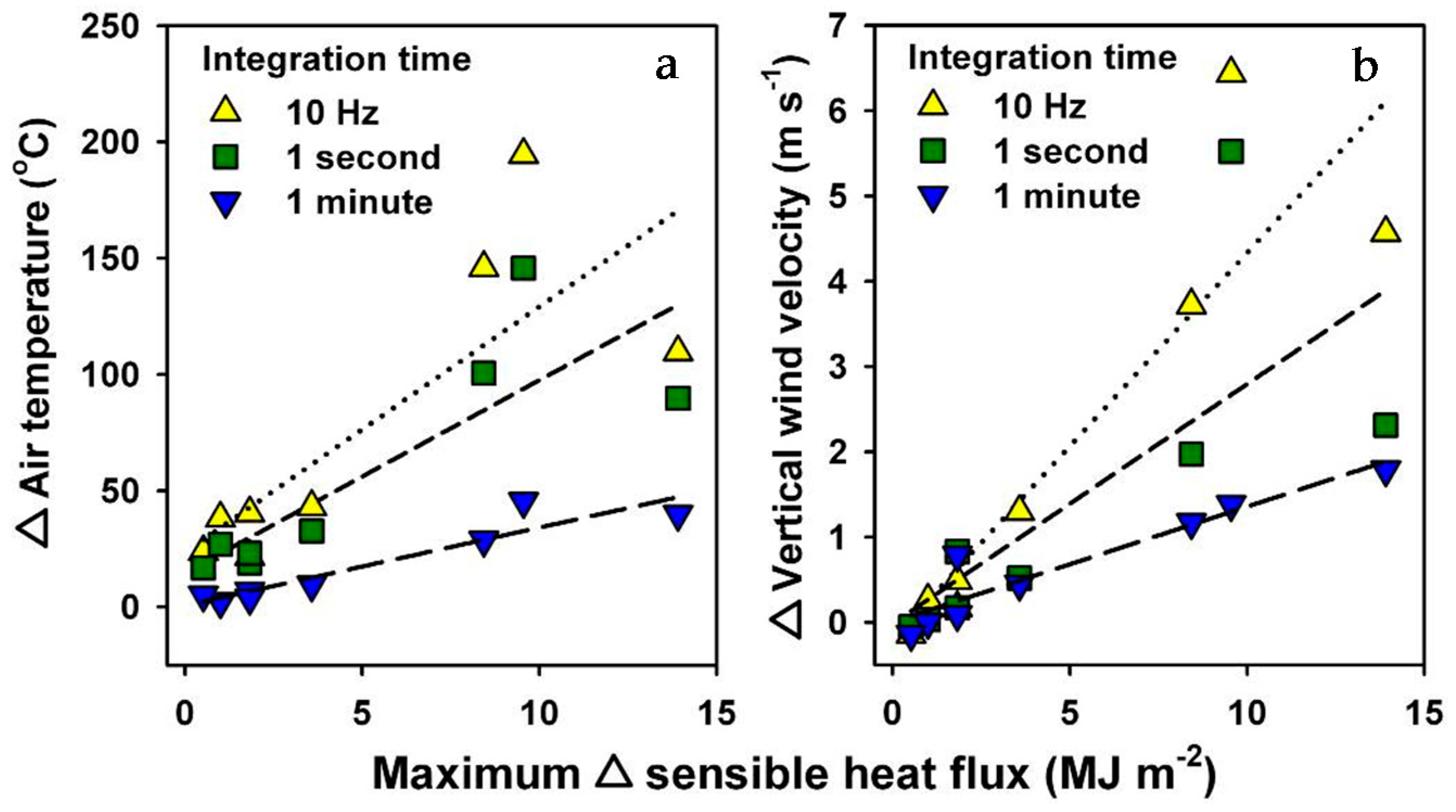1. Introduction
Prescribed fires are conducted extensively throughout North America because they are one of the most cost-effective methods to reduce hazardous fuels and mitigate the risk of severe wildfires [
1,
2,
3,
4]. In the Eastern USA, prescribed fires are also essential for the maintenance of fire-adapted ecosystems, such as those dominated by pines and oaks [
5,
6,
7,
8]. Beneficial aspects of fire in promoting biodiversity in pine- and oak-dominated forests are well documented [
6,
9,
10,
11]. In addition, prescribed fires may enhance forest resilience to other disturbances such as insect infestations [
12,
13]. However, because prescribed fires can result in significant emissions of particulate matter and regulated pollutants, smoke management has become an important issue when they are conducted near larger human population centers in the Eastern USA [
14,
15,
16]. Additional constraints to the use of prescribed fire involve reducing the risk of escapes by limiting ember production and transport and controlling fire perimeters in areas with high property values.
Fire behavior during prescribed fires is influenced by a number of factors, including fuel loading and arrangement [
1,
17,
18,
19], fuel moisture content, previous and current weather conditions [
20], and ignition pattern [
21]. Fuel loading and consumption during prescribed fires have been quantified throughout fire-adapted forest ecosystems in the Eastern USA, and several studies have documented significant linear relationships between initial fuel loading and consumption of forest floor and understory vegetation across a range of fire intensities [
19,
22,
23]. Wildland fire managers typically conduct prescribed burns within a constrained range of fuel moisture contents and meteorological conditions, with wind speed, ambient air temperature and relative humidity especially important for maintaining desired fire behavior and fire line control. Ignition pattern influences fire behavior because commonly employed spot or linear ignitions can result in a variety of fire behaviors, ranging from low-intensity backing fires to high-intensity head fires with crowning behavior.
Quantitative information on how firing pattern and the resultant fire behavior control the consumption of surface, understory and canopy fuels during prescribed fires is important for optimizing the effectiveness of fuel reduction treatments, while simultaneously minimizing the adverse impacts of smoke dispersion on local air quality and firebrand transport on unwanted ignitions. Low-intensity backing fires reduce surface and understory fuels, but when conducted under conditions where smoke dispersion is inadequate, they can result in undesirable impacts of smoke in local communities and along transportation corridors. In contrast, high-intensity fires can achieve fuel reduction objectives and adequate smoke dispersion, but ember transport and increased difficulty in fire line control enhances the risk of escapes. Despite the benefits and increased use of prescribed fire, tradeoffs between fire behavior, consumption of fuels, and turbulence and energy fluxes in buoyant plumes which control smoke dispersion and ember transport remain to be evaluated for many fire-adapted forests in the Eastern USA [
15,
24,
25].
Our central objective was to quantify how fire behavior and fuel consumption were related to turbulence and energy fluxes across a range of fire intensities. More specifically, we asked what the relationships between fuel loading and consumption are during low- and high-intensity prescribed fires conducted by State and Federal wildland fire managers in the Pinelands National Reserve (PNR) of Southern New Jersey, and how in turn does fire intensity influence above-canopy turbulent transfer and heat fluxes in the fire environment. We concentrated our efforts on sites dominated by pitch pine (
Pinus rigida Mill.) and shortleaf pine (
Pinus echinata Mill.), because these have a higher incidence of wildfires compared to other forest types in the Northeast USA and are a major focus of fuel reduction treatments by State and Federal wildland fire managers in the PNR [
26,
27,
28,
29]. They are also adjacent to densely populated suburban areas and transportation networks where smoke management and fire line control are critical. We analyzed new and previously published data from eight prescribed fires, ranging in intensity from low-intensity backing fires to high-intensity head fires. Five low-intensity fires resulted from either the ignition of backing fires or relatively low initial surface and understory fuel loads, and three high-intensity fires resulted from either a flanking fire with some crown torching or the ignition of head fires. We then evaluated the relationships between predominant fire behavior and fire intensity, loading and consumption of surface, understory and canopy fuels, and above-canopy turbulence and energy fluxes.
4. Discussion
We quantified the linkages between fire behavior (backing vs. head fires) and fire intensity, fuel loading and consumption, and above-canopy turbulence and energy fluxes during eight prescribed fires in pine-dominated forests in the Pinelands National Reserve. These fires encompassed much of the range of fire behavior and fire intensities employed by the New Jersey Forest Fire Service and Federal wildland fire managers during operational fuel reduction treatments, and illustrate some of the tradeoffs involved when wildland fire managers attempt to optimize the effectiveness of prescribed fires while simultaneously minimizing the adverse impacts of smoke and risk of escapes. Low-intensity backing fires were as effective as high-intensity fires at reducing fine and woody fuels on the forest floor, with residence times of low-intensity flame fronts a major factor in the consumption of these fuels [
23,
36]. Low-intensity fires resulted in minimal ladder or crown fuel consumption regardless of surface and understory fuel loading, and this limited fire intensity and above-canopy turbulence and heat flux. However, above- and within-canopy turbulence measurements reported here and in related studies [
14,
15,
25] indicate that low-intensity fires may not generate sufficient turbulence to disperse smoke from within the forest canopy, which can result in hazardous conditions on nearby highways and smoke impacts to surrounding communities [
16,
42,
43]. High-intensity head fires resulted in relatively rapid consumption of surface and understory fuels, and greater consumption of ladder and crown fuels. They also resulted in enhanced above-canopy turbulence and heat flux, increasing the turbulent transfer of smoke and firebrands above the canopy [
44,
45]. In some cases, high-intensity fires are preferable for fuel reduction and their ecological benefits but are usually not feasible to conduct in populated areas because of fire-line control and smoke management issues near non-attainment areas for fine particulates, ozone, and other regulated pollutants. Quantitative measures of fuel consumption and above-canopy turbulence and heat fluxes reported here, along with within-canopy and near-surface measurements (e.g., [
15,
25]), can provide important information for the evaluation of recently-developed physics based fire behavior models targeted at simulating prescribed fires (e.g., QUIC-Fire; [
46]), and smoke dispersion models which include the effects of forest canopies on turbulence regimes [
14,
47,
48]. Ultimately, these efforts will assist wildland fire managers design and conduct prescribed fires by employing ignition patterns optimized for desired fire behavior and fuel consumption while simultaneously minimizing impacts to public safety and air quality.
Several sources of uncertainty associated with measurements of fuel loading and consumption, and with the use of eddy covariance sensors in the fire environment can be identified that potentially affected the results of our study. Because estimated fuel consumption was used to calculate total heat of combustion, and along with fuel moisture measurements, partitioning of energy fluxes during each fire, uncertainty in these measurements also influence our energy flux estimates.
Uncertainty in the estimation of fuel consumption from destructively harvested plots pre- and post-burn was dependent on fuel type. When variation in pre-loading measurements for all stands were considered together, the coefficient of variation (CV; standard deviation/mean) for fine fuels on the forest floor averaged only 26 ± 8%, while the CV for understory vegetation averaged 74 ± 22%, reflecting the increased spatial variability in shrub and scrub oak distribution at a 1 m scale. A second potential source of error was the omission of char particles < 2 mm diameter that were produced during combustion of the forest floor, because we sifted many of the forest floor samples through 2 mm mesh size screens to remove sand and finer, undifferentiated organic matter derived from the uncombusted forest floor material in the O horizon. Despite these potential measurement errors, pre- and post-burn fuel loadings reported here are within the range of previously measured fuel loads on the forest floor, understory, and canopy in the Pinelands National Reserve [
23,
35,
37,
38]. Average values for pre- and post-burn fuel loading reported here are slightly lower than in previously measured pine–oak and pitch pine–scrub oak stands burned at typical intervals in the PNR (
Table A5; data from [
23]). Fuel consumption estimated for the prescribed burns reported here is within the range of values reported by Clark et al. [
23] for 25 prescribed burns in the PNR, where fuel consumption also was a strong linear relationship of initial fuel loading (
Table A5). In these previous analyses, initial loading explained 70%, 76% and 73% of the variation in consumption of fine fuels on the forest floor, 1 h + 10 h woody fuels on the forest floor, and understory vegetation, respectively. Significant linear relationships between surface and understory fuel loading and consumption have also been demonstrated at the plot scale for individual fires [
36] and across a wider range of fire intensities, including wildfires, in the PNR [
29].
The use of sonic anemometers in eddy covariance systems in the fire environment can also result in potential sources of error, primarily because of difficulties in accurately quantifying air temperature and turbulence in buoyant plumes during fire front passage (e.g., [
24,
49]). Pre- and post-burn measurements in burn areas and all measurements at control towers likely characterized turbulence and energy fluxes reasonably well. Long-term energy flux measurements made pre- and post-prescribed fire using identical instrumentation at three of the burned stands (Fort Dix, Cedar Bridge, and Silas Little Experimental Forest) indicate that half hourly sensible and latent heat fluxes accounted for 93% to 98% of the sum of net radiation, soil heat flux, and heat storage terms in the canopy air space and in biomass [
39]. However, sonic anemometers operating at 10 Hz may underestimate instantaneous fluxes during enhanced turbulence occurring at higher frequencies in buoyant plumes during fire front passage [
50]. Additional uncertainty may arise because flux measurements sample only a limited portion of the flame front, thus the distribution of fire intensities may not be completely captured in the footprint sampled by tower-mounted sensors, especially during high-intensity head fires (e.g., [
36]). This is likely one of the reasons that mismatches occur between convective heat fluxes estimated from fuel consumption and integrated Δ sensible heat fluxes shown in
Figure 4. During high-intensity head fires, crowning activity in the vicinity of burn area towers led to relatively high values for Δ sensible heat flux values compared to convective heat fluxes calculated from burn area-averaged fuel consumption estimates; when low-intensity versus high-intensity fires were compared, average integrated Δ sensible heat flux values were 70 ± 17% vs. 112 ± 42% of estimated convective heat fluxes, respectively. This result highlights the importance of quantifying the relationships between fire behavior, especially rate of spread and residence time of low-intensity fires, fine-scale measurements of fuel loading and consumption, and their linkage to turbulence and energy flux footprints in future investigations. Additional heat storage in the canopy airspace, in biomass, unconsumed forest floor material, and in soil likely accounted for much of the remaining energy during low-intensity fires. Tower-based measurements of Δ latent heat fluxes did account for nearly all of the estimated latent heat calculated from biometric and fuel moisture measurements during three of the low-intensity fires. We also found that smoke particles occasionally interfered with the sonic anemometer sensor heads, and air temperatures associated with buoyant plumes were occasionally out of range of equipment specifications. In the high-intensity head fires with some crown torching conducted at Warren Grove in 2013 and 2014, two of the sonic anemometers were damaged during fire front passage, but the closely associated thermocouples were not impacted. Thus, some important information could not be collected. Future investigations would benefit from more robust sonic anemometers operating at higher sampling frequencies.
A third source of uncertainty arises from the accurate assessment of ambient conditions during the prescribed fires. Often, ambient conditions are inferred from pre- and/or post-burn measurements from the same tower that the sampled the fire, assuming that conditions were similar to those during the fire event (e.g., [
15,
25,
49]). In this study, we attempted to reduce this potential source of error by using data from independent control towers, and calculated Δ air temperatures, Δ turbulence statistics, and Δ energy fluxes over time periods sampled simultaneously. However, sensor separation due to distances between burn area and control towers also likely influenced all Δ values because different local environments can have substantially different turbulence characteristics. Additionally, during the high-intensity fire conducted near Warren Grove in 2014, it is possible that the control tower may have been influenced by turbulence generated by the high-intensity fire because of its relatively close position on the landscape [
36].
Despite these potential methodological limitations, several recent investigations have used similar suites of eddy covariance and meteorological instrumentation and data reduction techniques to successfully quantify turbulence and energy fluxes in the fire environment (e.g., [
15,
24,
49]). Previous analyses by Heilman et al. [
15,
25] using profile data from the prescribed fires conducted in 2011 and 2012 analyzed here document how fire front passage modifies the structure of wind fields within and above the canopy, with greatest vertical and horizontal wind perturbations occurring just above the canopy. They also show that horizontal wind velocities associated with buoyant plumes can exceed vertical wind velocities and discuss the importance of interactions between fire front passage and canopy structure in altering patterns of turbulent transfer in buoyant plumes. Recent analyses indicate that the slopes of the relationship between air temperature and vertical wind velocity in buoyant plumes above flame fronts increase significantly with height above the ground. For the 2011 prescribed fire in a pine–oak stand reported here, slopes of this relationship were 0.018, 0.028 and 0.048 at 3, 10 and 20 m measurement heights, respectively. We have observed similar increases in slopes of these relationships with height above flame fronts in a range of experiments where sonic anemometers were arranged in vertical profiles. Clements et al. [
24] also indicate that even during low-intensity fires, fire-atmosphere interactions significantly modify turbulence structure and energy fluxes. Convective heating associated with buoyant plumes during fire front passage during their measurements resulted in a peak 1 minute heat flux of 15.2 kW m
−2 during a low-intensity flanking fire during the RxCadre campaign. For comparison, we measured peak 10 minute values of 3.6, 2.8 and 18.0 kW m
−2 during low-intensity fires with low fuel loading, low-intensity fires with moderate fuel loading, and high-intensity fires, respectively.
Quantifying turbulence and energy fluxes across a range of fire intensities during operational fuel reduction treatments will contribute to the development of more robust and accurate tools for predicting fire behavior and smoke dispersion from prescribed fires (e.g., [
14,
15,
16,
25,
46]). Computationally intensive, physics based models for simulating fuel combustion and fire behavior (e.g., Wildland Urban Interface Fire Dynamics Simulator (WFDS); [
51,
52], FIRETEC; [
53] and QUIC-Fire; [
46]), explicitly account for the processes driving fire behavior by coupling and scaling individual component processes at the fuel bed and fire scales with interactions between ambient wind fields, forest structure, and buoyancy- and shear-induced turbulence on the scale of a fire’s plume. Smoke emission and dispersion models (e.g., ARPS-CANOPY/FLEXPART and the BLUESKY modeling framework [
14,
47,
48,
54]) couple estimates of fuel consumption and particulate emissions with Lagrangian transport models, and account for characteristics of the forest canopy and how it affects fire-induced turbulence within and above vegetation layers to simulate smoke concentrations during low- and high-intensity fires. A number of model predictions can be evaluated using micrometeorological data collected during fires, but large-scale field experiments such as those reported here have only recently been conducted frequently enough to provide sufficient information to evaluate detailed relationships between ignition pattern and fire behavior, fuel consumption and turbulence and energy fluxes in the fire environment. Continuation of multi-scale experiments that couple above- and within-canopy turbulence and energy flux measurements with more precise measurements of fuel combustion physics such as those conducted under the Department of Defense-sponsored Strategic Environmental Research Program (SERDP) [
55] and the multi-agency Fire and Smoke Model Evaluation Experiment (FASMEE) [
56] will add considerably to these efforts.
